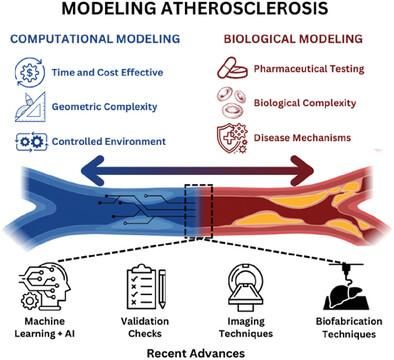Our official English website, www.x-mol.net, welcomes your feedback! (Note: you will need to create a separate account there.)
Integrating Computational and Biological Hemodynamic Approaches to Improve Modeling of Atherosclerotic Arteries
Advanced Science ( IF 15.1 ) Pub Date : 2024-05-05 , DOI: 10.1002/advs.202307627 Thao Nhu Anne Marie Vuong 1 , Michael Bartolf‐Kopp 2 , Kristina Andelovic 2 , Tomasz Jungst 2, 3 , Nona Farbehi 1, 4, 5 , Steven G. Wise 6 , Christopher Hayward 7 , Michael Charles Stevens 1 , Jelena Rnjak‐Kovacina 1, 4, 8
Advanced Science ( IF 15.1 ) Pub Date : 2024-05-05 , DOI: 10.1002/advs.202307627 Thao Nhu Anne Marie Vuong 1 , Michael Bartolf‐Kopp 2 , Kristina Andelovic 2 , Tomasz Jungst 2, 3 , Nona Farbehi 1, 4, 5 , Steven G. Wise 6 , Christopher Hayward 7 , Michael Charles Stevens 1 , Jelena Rnjak‐Kovacina 1, 4, 8
Affiliation

|
Atherosclerosis is the primary cause of cardiovascular disease, resulting in mortality, elevated healthcare costs, diminished productivity, and reduced quality of life for individuals and their communities. This is exacerbated by the limited understanding of its underlying causes and limitations in current therapeutic interventions, highlighting the need for sophisticated models of atherosclerosis. This review critically evaluates the computational and biological models of atherosclerosis, focusing on the study of hemodynamics in atherosclerotic coronary arteries. Computational models account for the geometrical complexities and hemodynamics of the blood vessels and stenoses, but they fail to capture the complex biological processes involved in atherosclerosis. Different in vitro and in vivo biological models can capture aspects of the biological complexity of healthy and stenosed vessels, but rarely mimic the human anatomy and physiological hemodynamics, and require significantly more time, cost, and resources. Therefore, emerging strategies are examined that integrate computational and biological models, and the potential of advances in imaging, biofabrication, and machine learning is explored in developing more effective models of atherosclerosis.
中文翻译:

整合计算和生物血流动力学方法来改进动脉粥样硬化动脉的建模
动脉粥样硬化是心血管疾病的主要原因,导致死亡、医疗费用增加、生产力下降以及个人及其社区的生活质量下降。由于对其根本原因的了解有限以及当前治疗干预措施的局限性,这一问题加剧了,这凸显了对复杂动脉粥样硬化模型的需求。这篇综述批判性地评估了动脉粥样硬化的计算和生物学模型,重点关注动脉粥样硬化冠状动脉的血流动力学研究。计算模型解释了血管和狭窄的几何复杂性和血流动力学,但它们未能捕获动脉粥样硬化涉及的复杂生物过程。不同的体外和体内生物模型可以捕获健康和狭窄血管的生物复杂性的各个方面,但很少模拟人体解剖学和生理血流动力学,并且需要更多的时间、成本和资源。因此,人们对整合计算和生物模型的新兴策略进行了研究,并探索了成像、生物制造和机器学习方面进步的潜力,以开发更有效的动脉粥样硬化模型。
更新日期:2024-05-05
中文翻译:

整合计算和生物血流动力学方法来改进动脉粥样硬化动脉的建模
动脉粥样硬化是心血管疾病的主要原因,导致死亡、医疗费用增加、生产力下降以及个人及其社区的生活质量下降。由于对其根本原因的了解有限以及当前治疗干预措施的局限性,这一问题加剧了,这凸显了对复杂动脉粥样硬化模型的需求。这篇综述批判性地评估了动脉粥样硬化的计算和生物学模型,重点关注动脉粥样硬化冠状动脉的血流动力学研究。计算模型解释了血管和狭窄的几何复杂性和血流动力学,但它们未能捕获动脉粥样硬化涉及的复杂生物过程。不同的体外和体内生物模型可以捕获健康和狭窄血管的生物复杂性的各个方面,但很少模拟人体解剖学和生理血流动力学,并且需要更多的时间、成本和资源。因此,人们对整合计算和生物模型的新兴策略进行了研究,并探索了成像、生物制造和机器学习方面进步的潜力,以开发更有效的动脉粥样硬化模型。






























 京公网安备 11010802027423号
京公网安备 11010802027423号